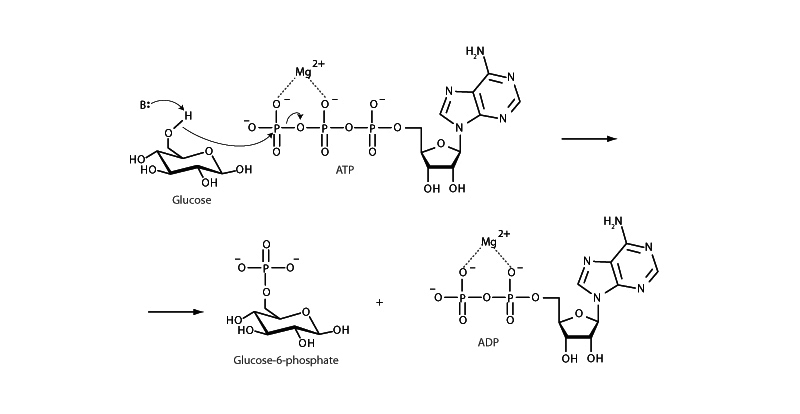Interdisciplinary Note (1 of 9)
Hexokinase is the first enzymatic step in the glycolytic pathway. Hexokinase utilizes an ATP to phosphorylate a molecule of glucose forming the product glucose-6-phosphate. In a very real sense, a cell is laying claim to a glucose through the hexokinase step. Although glucose is polar, an unphosphorylated glucose is small enough that it can slowly leak across a membrane. Glucose would slowly equilibrate across membranes if it were not phosphorylated, but glucose-6-phosphate is an ion, on the other hand, and ions don't cross without a channel.
Even though the cell is laying claim to the glucose through hexokinase, hexokinase does not represent the committed step. Just because hexokinase occurred does not mean that the glucose is fated to enter glycolysis. Within a hepatocyte where both glucose and ATP are high, under insulin signal, the enzyme phosphoglucomutase converts the glucose-6-phosphate into glucose-1-phosphate. Now the glucose is on the way to glycogen synthesis. Insulin activated glycogen synthase will be pulling the glucose in that direction.
Alternatively, if there is a need for NADPH in the cell, the enzyme glucose-6-phosphate dehydrogenase will be activated. Glucose-6-phosphate dehydrogenase is the first step in the pentose phosphate pathway, which will ultimately convert the glucose to ribose-5-phosphate and in the process form two molecules of NADPH. (NADPH possesses the same basic chemistry as NADH. However the purpose of NADPH is not bringing reducing equivalents to energy metabolism (electron transport) but providing reducing equivalents for biosynthesis and for the fight against oxidative stress).
In other words, glucose-6-phosphate isn't so much an intermediate in glycolysis but a crossroads between a number of pathways. Depending on the type of cell, its energy charge, metabolome, and signaling, the glucose-6-phosphate may be destined for glycolysis, glycogen synthesis, or the pentose phosphate pathway.
The actual committed step in glycolysis is two steps later, the phosphofructokinase I (PFK I) step, which converts fructose-6-phosphate into fructose-1-6-bisphosphate.
